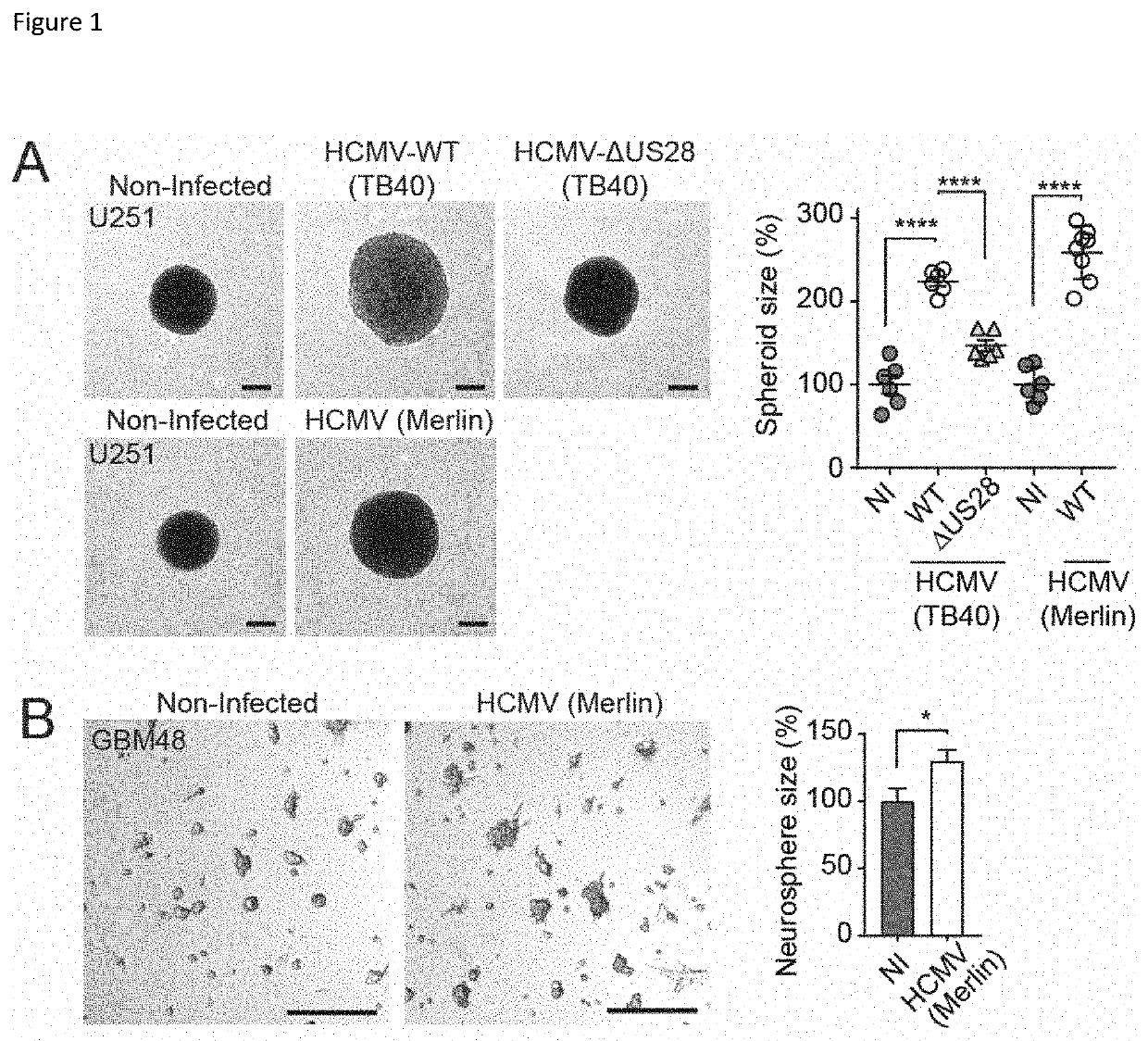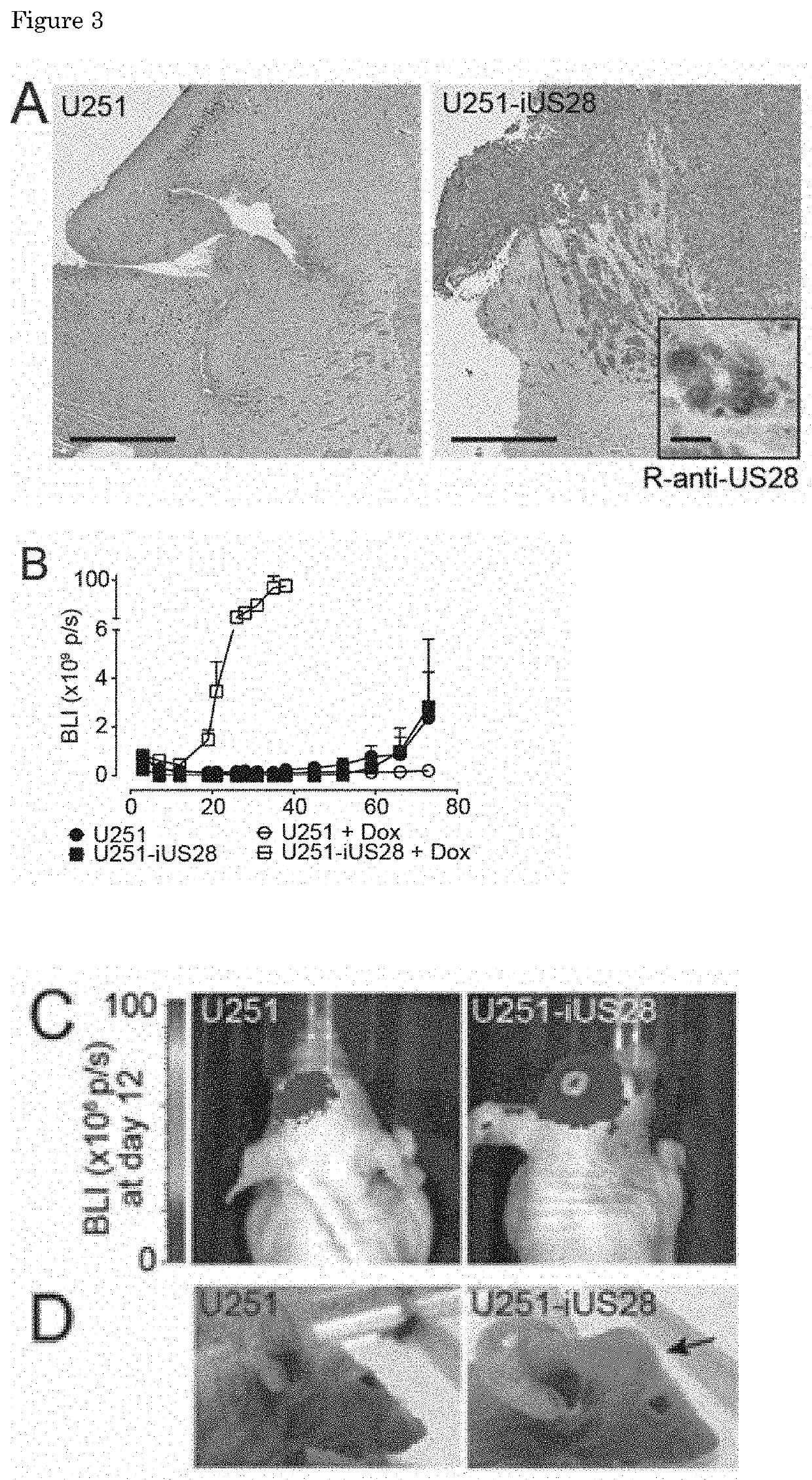Inverse Agonistic Anti-US28 Antibodies
a technology of anti-us28 and inverse agonist, applied in the field of virology, can solve the problems of poor survival of gbm patients, moderate to high-grade hcmv infection, etc., and achieve the effect of improving clinical outcom
- Summary
- Abstract
- Description
- Claims
- Application Information
AI Technical Summary
Benefits of technology
Problems solved by technology
Method used
Image
Examples
example 1
Materials and Methods
[0098]Reagents
Human chemokines CCL5 and CX3CL1 were obtained from PeproTech, Rocky Hill, N.J., USA. Dulbecco's modified Eagle's medium (DMEM), Dulbecco's Phosphate-buffered saline (D-PBS), trypsin-EDTA and Poly-L-lysine solution were obtained from Sigma-Aldrich, Saint Louis, Mo., USA. Fetal bovine serum (FBS) and penicillin / streptomycin were obtained from PAA Laboratories GmbH, Cölbe, Germany. 125I-Na and myo-[2-3H] inositol (1 mCi / ml) were obtained from Perkin Elmer Life Sciences, Waltham, Mass., USA. Mouse anti-cytomegalovirus (immediate early antigen; MAB180R) was obtained from Merck Millipore, Billerica, Mass., USA. Polyclonal rabbit-anti-US28 antibodies were generated by Covance (Princeton, N.J., USA) as described previously (Bongers et al., 2010. J Clin Invest 120: 3969-78). Anti-Myc tag (clone 9B11, #2276) was obtained from Cell Signaling Technology, Danvers, Mass., USA. Horseradish peroxidase (HRP)-conjugated antibodies (U.S. Pat. Nos. 1,706,515 and 1,70...
example 2
Materials and Methods
[0115]As in Example 1.
Results
[0116]Identification of Novel Anti-US28 Antibody
To find new US28-targeting antibodies, llamas were immunized with DNA encoding for US28 from the HCMV-strain VHL / e. Phage libraries with VHH genes in frame with geneIII of an M13 phagemid vector, were generated using RNA from peripheral blood mononuclear cells from these llamas. Upon 3 rounds of panning selections on US28-membrane extracts, 330 clones were screened for selective binding to US28 by means of a phage ELISA. US28-binding VHH clones were grouped in families based on the sequence of the CDR3 region. Interestingly, one of these VHH-families contained a similar, relatively short CDR3 as the previously identified US28 VHH. This new VHH was designated VUN100 (VU University Nanobody 100) and was further characterized as purified protein (FIG. 8A). As a monovalent VHH, VUN100 bound US28 with an apparent binding affinity of 2±1 nM, which is ˜170 fold higher than the previously ident...
example 3
Material and Methods
[0121]Immunofluorescence Microscopy
[0122]Transiently transfected HEK293T cells were seeded in poly-L-lysine (Sigma-Aldrich) coated 96 well plates and were grown at 37° C. and 5% CO2. After 48 h, cells were fixed for 10 min at RT with 4% paraformaldehyde (PFA, Sigma-Aldrich) in PBS. Cells were washed with PBS and permeabilized for 30 min at RT with 0.5% NP-40 (Sigma-Aldrich) in PBS. Cells were washed again with PBS and wells were blocked with 1% (v / v) FBS in PBS for 1 h at RT. Nanobody (100 nM in 1% (v / v) FBS / PBS) was added to the wells and incubated for 1 h at RT. Cells were washed with PBS and afterwards incubated with Mouse-anti-Myc antibody (1:1000 in 1% (v / v) FBS / PBS, Clone 9B11, Cell Signaling). Cells were washed again with PBS and subsequently incubated with Goat-anti-Mouse-Alexa Fluor 488 (1:1000 in 1% (v / v) FBS / PBS, Thermo Fisher Scientific) for 1 h at RT. Cells were washed again with PBS and cell nuclei were stained with 4′, 6-diamidino-2-phenylindole (D...
PUM
| Property | Measurement | Unit |
|---|---|---|
| v/v | aaaaa | aaaaa |
| pH | aaaaa | aaaaa |
| pharmaceutical composition | aaaaa | aaaaa |
Abstract
Description
Claims
Application Information
 Login to View More
Login to View More - R&D
- Intellectual Property
- Life Sciences
- Materials
- Tech Scout
- Unparalleled Data Quality
- Higher Quality Content
- 60% Fewer Hallucinations
Browse by: Latest US Patents, China's latest patents, Technical Efficacy Thesaurus, Application Domain, Technology Topic, Popular Technical Reports.
© 2025 PatSnap. All rights reserved.Legal|Privacy policy|Modern Slavery Act Transparency Statement|Sitemap|About US| Contact US: help@patsnap.com



